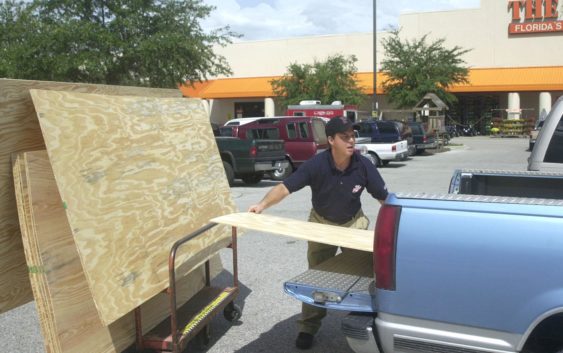- Watering trees is a must to protect them from severe weather and drought
- At least 4 dead, hundreds rescued after deadly floods ravage South Texas
- Today on Texas Standard: Deadly floods swamp South Texas, shatter records
- North Carolina radio station was a critical lifeline after Hurricane Helene. Then it became the voice of recovery.
- As storms approach, Rock Hill residents look back on last April's devastating hailstorm
Hurricane tips: Before, during and after the storm

Days before the storm
EQUIPMENT: Board up windows and glass doors, anchor loose yard objects or bring them inside and lock your doors.
YOUR STUFF: Move furniture away from exposed doors and windows. Cover furniture, computers and electronics with plastic. Take photographs of your items in case you have to file a damage claim after the storm.
YOUR LOCATION: Evacuate if told to do so. Map out your route using roads specified by local authorities.
YOUR CAR: Fill your car with gasoline well in advance to avoid long lines and chaos. Get cash. After hurricanes, banks and ATMs may be temporarily closed.
During the storm
ELECTRICITY: Water conducts electricity; do not run water during lightning storms or stand in water outdoors. Never enter flooded areas or touch electrical equipment if the ground is wet unless you are certain that the power is off. If water has been present anywhere near electrical circuits and electrical equipment, turn off the power at the main breaker or fuse on the service panel.
POWER FAILURES: If a power failure is likely to last longer than a few hours, turn off your range, toaster oven, iron and other items that could cause a fire if you aren’t home when power is restored. Turn off air conditioners and water heaters to prevent system overloads when power is restored. Wait 30 minutes once power is restored to operate them.
ELECTRIC SHOCK: If anyone suffers from electric shock, call 911 immediately. Even minor shocks can cause life-threatening conditions hours later.
GENERATORS: When using gasoline and diesel generators to supply power to a building, switch the main breaker or fuse on the service panel to the “off” position before starting the generator. Never connect a generator to your home’s electrical system. Connect appliances directly with properly sized power cords, and make sure the generator is grounded.
CARBON MONOXIDE: It is an odorless, colorless gas that is poisonous to breathe. During flood cleanup, operate all gasoline-powered devices such as pumps, generators and pressure washers outdoors; never bring them indoors.
WATER: Hurricanes, especially if accompanied by a tidal surge or flooding, can contaminate the public water supply. Drinking contaminated water will cause illness. You cannot assume that the water in the hurricane-affected area is safe to drink. Listen for public announcements about the safety of the municipal water supply. If your well has been flooded, it needs to be tested and disinfected after the storm passes and the floodwaters recede. Questions about testing should be directed to local or state health department. Do not use contaminated water to wash dishes, brush teeth, wash and prepare food, wash your hands, make ice or baby formula. If possible, use baby formula that does not need to have water added. Boiling water is the preferred way to kill harmful bacteria and parasites. Bringing water to a rolling boil for one minute will kill most organisms. When boiling water is not practical, you can treat water with chlorine tablets, iodine tablets or unscented household chlorine bleach. If you use chlorine tablets or iodine tablets, follow the directions that come with the tablets. If you use household chlorine bleach, add 1/8 teaspoon of bleach per gallon of water if the water is clear. For cloudy water, add 1/4 teaspoon of bleach per gallon. Mix the solution thoroughly and let it stand for about 30 minutes before using it. (Note: Treating water with chlorine tablets, iodine tablets or liquid bleach will not kill parasitic organisms.)
After the storm
In addition to taking precautions to prevent illness and injury, there are steps that hurricane victims should take when the storm is over:
LISTEN/READ: Keep listening to NOAA Weather Radio or local radio or TV stations for instructions, read the StarNews in print or get more online at StarNewsOnline.com.
FLOODED FOOD, EQUIPMENT: After a flood, wear gloves, boots, a long-sleeved shirt and long pants to clean up. Discard food or water that came into contact with flood water, including canned goods. Discard porous nonfood items used with food if they have been contaminated by flood water, including picnic goods, cosmetics and medicines, pacifiers and bottle nipples, and containers and utensils.
SANITIZE: To sanitize dishes and glassware, wash them with dishwasher detergent using a scrub brush. Then immerse for 15 minutes in a solution of one teaspoon chlorine bleach per quart of room temperature water. Disinfect metal pans and utensils by boiling them in clean or treated water for 10 minutes. Use a solution of one teaspoon bleach per quart of water to clean kitchen counters and other food preparation surfaces as well as inside refrigerators and freezers.
REPAIRS: Beware of repair scams. Don’t be rushed into signing a contract with any company. Instead, collect business cards and get written estimates for the proposed job. Investigate the track record of any roofer, builder or contractor that you consider hiring. Call the Better Business Bureau for help.
Sources: American Red Cross, Federal Emergency Management Agency, Insurance Information Institute